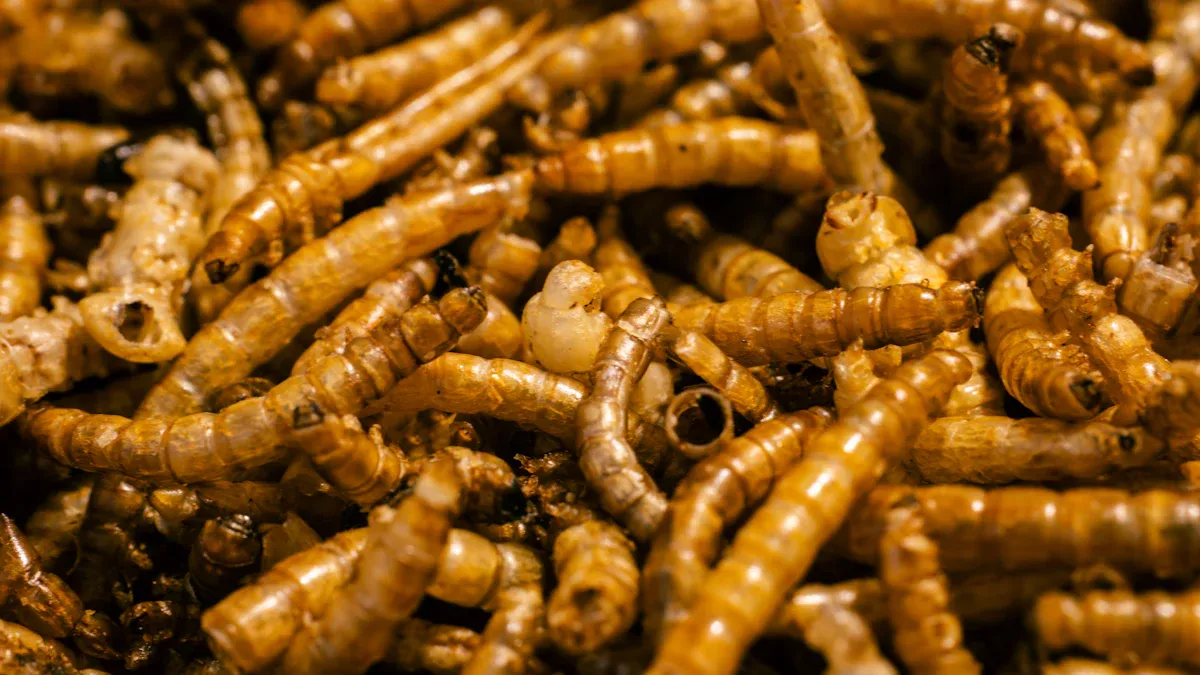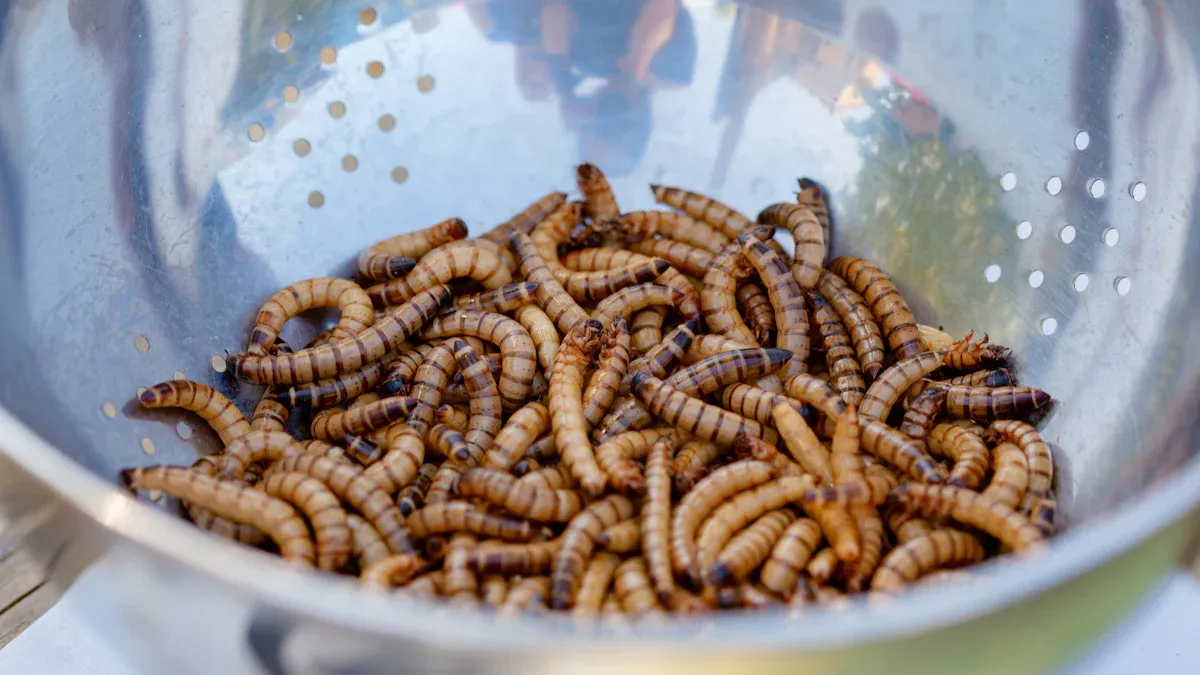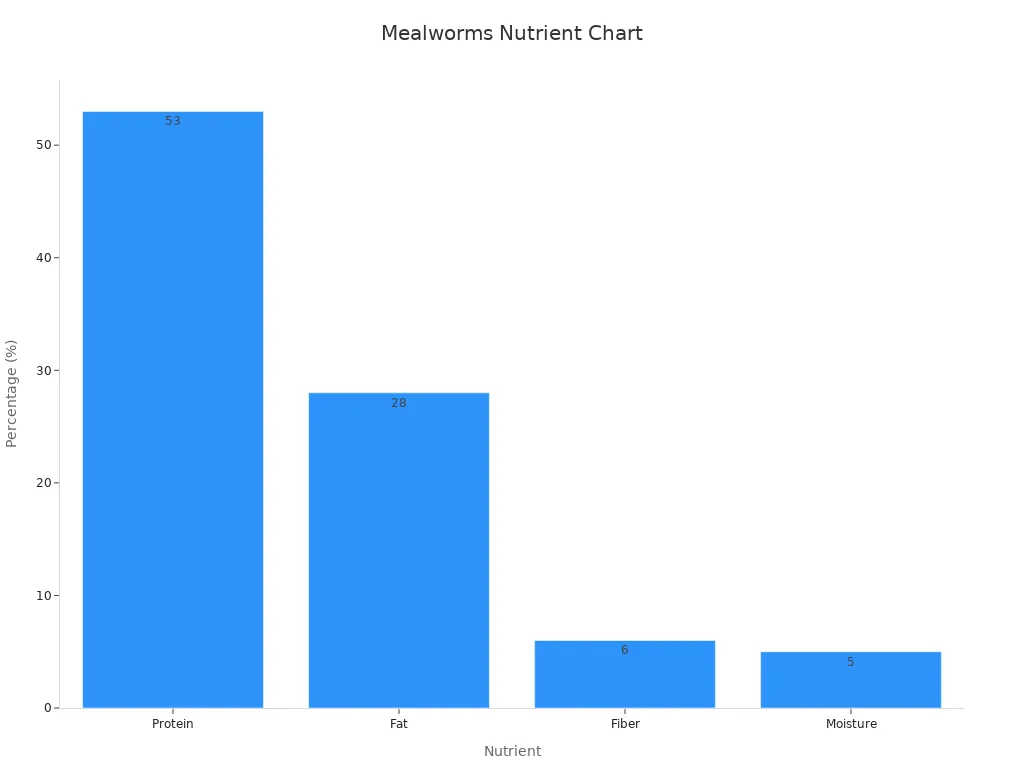
Are dried mealworms a good option for fish? Absolutely! They’re packed with nutrients like crude protein (46%-52%) and essential amino acids, rivaling fish meal in quality. Plus, their fat content (25%-35%) supports energy needs. Feeding Fish with Dried Mealworms is a simple way to boost fish health while keeping their diet exciting and varied.
Key Takeaways
- Dried mealworms are a healthy food for fish. They have lots of protein (up to 53%) and important nutrients that help fish grow and stay healthy.
- Soak dried mealworms in water before feeding. This makes them easier to digest and feel like live food, which fish like more.
- Feed mealworms differently based on the type of fish. Sprinkle them for fish that eat at the top, sink them for fish at the bottom, and crush them for small fish so they can eat easily.
Benefits of Feeding Fish with Dried Mealworms

High Protein Content for Fish Growth
Protein is the building block of life, and fish need plenty of it to grow strong and healthy. Dried mealworms are an excellent source of protein, with a content of up to 47.9% dry matter when raised on wheat bran. This makes them a powerhouse food for fish, especially during growth stages.
Studies show that diets with higher protein levels significantly improve fish growth. For example:
- Fish fed with protein-rich diets experience greater live biomass gain.
- Larvae fed on protein-rich diets can achieve weight gains of up to 55.6 mg, compared to just 2.9 mg on protein-free diets.
By including dried mealworms in their diet, fishkeepers can ensure their aquatic pets get the protein they need for optimal growth.
Essential Nutrients for Fish Health
Dried mealworms don’t just provide protein—they’re packed with other essential nutrients that support overall fish health. These include amino acids, fats, and minerals that contribute to energy, immunity, and vitality.
Feeding fish with dried mealworms has been shown to:
- Enhance growth performance.
- Boost immune system enzyme activities, helping fish resist diseases.
- Improve disease resistance when used as a partial replacement for fish meal.
This nutrient-rich food can help fish thrive, making it a valuable addition to their diet.
Versatility and Convenience for Fishkeepers
One of the best things about dried mealworms is how easy they are to use. They’re lightweight, have a long shelf life, and don’t require refrigeration. Fishkeepers can feed them in various forms—whole, crushed, or even powdered—depending on the size and species of their fish.
Dried mealworms also add variety to a fish’s diet, which can stimulate natural feeding behaviors. Whether you’re caring for freshwater or saltwater fish, this versatile food option fits seamlessly into your routine. Plus, rehydrating them before feeding makes them even more palatable and easier to digest for your aquatic pets.
Tip: Keep a container of dried mealworms handy for a quick, nutritious treat that your fish will love!
How to Feed Fish with Dried Mealworms

Rehydrating Dried Mealworms Before Feeding
Rehydrating dried mealworms is an important step before feeding them to fish. While dried mealworms are convenient, their dehydrated state can make them harder for fish to digest. Soaking them in water for 10-15 minutes softens their texture and makes them more palatable. This process also mimics the natural moisture content of live prey, which fish instinctively prefer.
To rehydrate, simply place the dried mealworms in a bowl of clean, dechlorinated water. For added nutrition, some fishkeepers soak them in vitamin-enriched solutions. Once the mealworms have softened, drain the excess water and feed them to your fish. This small step ensures your fish get the most out of this nutritious treat.
Tip: Always use fresh water for soaking and avoid over-soaking, as this can cause the mealworms to lose some of their nutrients.
Feeding Techniques for Different Fish Species
Different fish species have unique feeding habits, so it’s essential to tailor your approach. For surface feeders like guppies and bettas, sprinkle the mealworms on the water’s surface. These fish will eagerly snap them up. For bottom-dwellers like catfish, sinking the mealworms or mixing them with sinking pellets works best.
Crushing or powdering dried mealworms is another option for smaller fish or fry. This makes it easier for them to consume the food without struggling. Larger fish, such as cichlids or koi, can handle whole mealworms. Observing your fish’s behavior during feeding can help you adjust the technique to suit their preferences.
Here’s a quick comparison of feeding techniques for different species:
| Fish Type | Feeding Technique | Notes |
|---|---|---|
| Surface Feeders | Sprinkle mealworms on the water’s surface | Ideal for guppies, bettas, and tetras. |
| Bottom-Dwellers | Sink mealworms or mix with sinking pellets | Suitable for catfish and loaches. |
| Small Fish or Fry | Crush or powder mealworms | Easier for smaller mouths to consume. |
| Large Fish | Feed whole mealworms | Perfect for cichlids and koi. |
Note: Always monitor your fish during feeding to ensure they’re eating comfortably and not leaving uneaten food behind.
Determining the Right Quantity and Frequency
Feeding the right amount of dried mealworms is crucial for maintaining fish health. Overfeeding can lead to water quality issues, while underfeeding may leave your fish malnourished. The quantity depends on the fish’s size, species, and life stage.
For larvae and juveniles, feed 6-10% of their body weight daily, divided into 4-6 meals. Adults require less—around 5% of their body weight, fed 2-3 times a day. Here’s a helpful table to guide you:
| Life Stage | Suggested Feeding Rate (% of BW) | Recommended Meals per Day |
|---|---|---|
| Larvae | 9–10% | 4-6 |
| Juveniles | 6–8% | 4-6 |
| Adults | 5% | 2-3 |
Feeding frequency also impacts growth and gut health. Studies show that feeding twice a day is optimal for most fish. Here’s a breakdown of how frequency affects fish:
| Feeding Frequency | Effect on Growth and Gut Health |
|---|---|
| 1 time/day | Not recommended |
| 2 times/day | Best for growth and gut health |
| 3 times/day | Moderate growth |
| 4 times/day | Less effective for gut health |
By following these guidelines, fishkeepers can ensure their aquatic pets thrive on a diet that includes dried mealworms.
Tip: Start with small portions and adjust based on how much your fish consume within a few minutes. Remove any uneaten food to keep the tank clean.
Addressing Concerns About Feeding Fish with Dried Mealworms
Are Dried Mealworms Safe for All Fish?
Dried mealworms are generally safe for most fish species. Their high protein and amino acid content make them a nutritious choice. Studies show that mealworms can replace up to 25% of fishmeal in diets without affecting growth or health. In shrimp farming, they’ve even been used to completely replace fishmeal, leading to increased body weight and lipid content.
However, not all fish have the same dietary needs. Smaller fish or fry may struggle with whole mealworms. Crushing or powdering them ensures they’re easier to consume. Always observe your fish during feeding to confirm they’re eating comfortably.
Managing Digestibility and Overfeeding Risks
Digestibility is a common concern when feeding dried mealworms. Their in vitro crude protein digestibility is 66.12%, which is quite high. Additionally, their amino acid content surpasses that of barley, fish, and beef, except for lysine.
To avoid overfeeding, fishkeepers should stick to recommended feeding quantities. Uneaten food can harm water quality, so it’s best to start with small portions. Rehydrating mealworms before feeding also improves digestibility, making them easier for fish to process.
Compatibility with Freshwater and Saltwater Fish
Dried mealworms are versatile and work well for both freshwater and saltwater fish. Fish fed mealworm-based diets show growth metrics similar to those fed high-quality fishmeal. This makes them a reliable option for various aquatic environments.
For freshwater species like guppies or cichlids, mealworms provide a protein boost. Saltwater species, such as clownfish, also benefit from their nutrient-rich profile. By including dried mealworms in their diet, fishkeepers can enhance the health of their aquatic pets.
Feeding fish with dried mealworms offers a simple way to enhance their diet. Packed with 53% protein, 28% fat, and other essential nutrients, these “nourishing bombs” support growth, energy, and overall health. Their versatility makes them suitable for various fish species, from guppies to oscar fish.

To get started, rehydrate the mealworms for easier digestion. Adjust feeding techniques based on your fish’s size and habits. Whether sprinkled on the surface or crushed for smaller fish, they’re a convenient and nutritious choice. Try incorporating dried mealworms into your fish’s diet today—you’ll see the difference in their vitality and growth!
Tip: Keep a container of dried mealworms handy for a quick, healthy treat your fish will love.
FAQ
Can dried mealworms replace fishmeal entirely in a fish’s diet?
Dried mealworms can replace up to 25% of fishmeal in most diets. For some species, like shrimp, they’ve been used as a complete replacement with excellent results.
How should I store dried mealworms to keep them fresh?
Store dried mealworms in an airtight container in a cool, dry place. This prevents moisture and keeps them fresh for months. No refrigeration is needed!
Are dried mealworms suitable for all fish sizes?
Yes, but preparation matters. Crush or powder them for smaller fish or fry. Larger fish can handle whole mealworms without any issues.
Tip: Always observe your fish during feeding to ensure they’re eating comfortably and adjust the mealworm size if needed.


